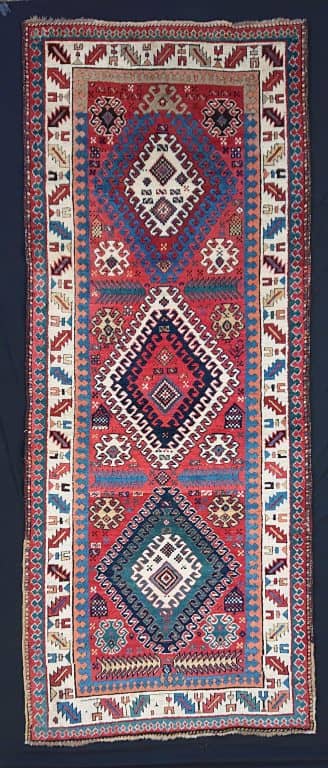Antique Northwest Persian Long Rug
SOLD
Antique Northwest Persian Long Rug
reference:
6976
dimensions:
288 x 116 cm
Description
This antique northwest Persian long rug was made towards the end of the nineteenth century by a village weaver, possibly a member of a Kurdish tribe.
The field is formed by three hooked concentric lozenges set on a deep red ground with a nice variation in the colour called abrash. At the bottom of each lozenge is a pair of inward facing chevrons in yellow, blue and green. These colours are repeated in the rest of the field in varying combinations.
Along the diagonals of each lozenge is a smaller diamond with protuberances, not unlike the “Hakkari-Shanbo gul” which Burns in his publication on Kurdish rugs describes as a heraldic, specifically Kurdish motif (James D Burns, Antique Rugs of Kurdistan. A Historical Legacy of Woven Art. James D Burns 2002, page 205). Given that Kurdish people could be found in many different areas of Persia, especially the northwest, it is not at all impossible that a non-Kurdish weaver might have been exposed to and picked up elements of a design language not necessarily her own.
Lying S shapes, four-and-one motifs and curious domed squares and rectangles with a checkerboard design and a “handle” (amulets?) complete the decoration of the field.
This is enclosed by two reciprocal borders around the main border with a so-called “serrated leaf and calyx” design. According to Burns, this border (its Kurdish name translating as “lotus and pine cones”) is very typical of Kurdish rugs (see op.cit., pages 27 – 28). However, you can also find this in some Anatolian and Caucasian rugs.
The rug is woven with soft wool and deep, saturated colours. It is in excellent condition, with a small patch at the bottom of the field and only two or three rows of knots missing in parts of the bottom end.
It would be a gladdening addition to anyone’s home.
SOLD

